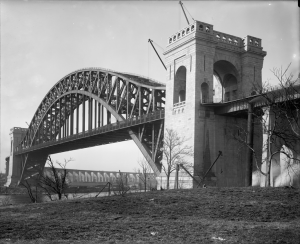
"In 1926, attracted by the building boom, three or four Caughnawaga, gangs came down." (Image by Detroit Publishing Co.)
From “The Mohawks in High Steel,” Joseph Mitchell’s 1949 New Yorker story about a Native American tribe’s contributions to NYC bridges and skyscrapers:
“Sometime in 1915 or 1916, a Caughnawaga bridgeman named John Diabo came down to New York City and got a job on Hell Gate Bridge. He was a curiosity and was called Indian Joe; two old foremen still remember him. After he had worked for some months as bucker‑up in an Irish gang, three other Caughnawagas joined him and they formed a gang of their own. They had worked together only a few weeks when Diabo stepped off a scaffold and dropped into the river and was drowned. He was highly skilled and his misstep was freakish; recently, in trying to explain it, a Caughnawaga said, ‘It must’ve been one of those cases, he got in the way of himself ‘ The other Caughnawagas went back to the reservation with his body and did not return. As well as the old men in the band can recollect, no other Caughnawagas worked here until the twenties. In 1926, attracted by the building boom, three or four Caughnawaga, gangs came down. The old men say that these gangs worked first on the Fred F. French Building, the Graybar Building, and One Fifth Avenue. In 1928, three more gangs came down. They worked first on the George Washington Bridge. In the thirties, when Rockefeller Center was the biggest steel job in the country, at least seven additional Caughnawaga gangs came down. Upon arriving here, the men in all these gangs enrolled in the Brooklyn local of the high-steel union, the International Association of Bridge, Structural, and Ornamental Iron Workers, American Federation of Labor. Why they enrolled in the Brooklyn instead of the Manhattan local, no one now seems able to remember. The hall of the Brooklyn local is on Atlantic Avenue, in the block between Times Plaza and Third Avenue, and the Caughnawagas got lodgings in furnished‑room houses and cheap hotels in the North Gowanus neighborhood, a couple of blocks up Atlantic from the hall. In the early thirties, they began sending for their families and moving into tenements and apartment houses in the same neighborhood. During the war, Caugh nawagas continued to come down. Many of these enrolled in the Manhattan local, but all of them settled in North Gowanus.”
